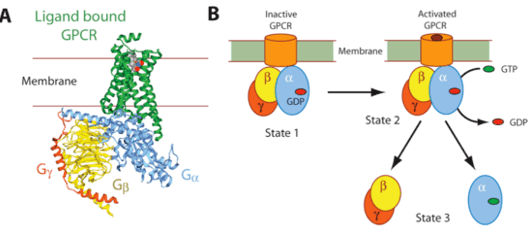Learn more about how GNB1 affects the body
GNB1 Syndrome is a rare disease (<100 known cases worldwide) caused by a mutation in the GNB1 gene. The Syndrome was first identified in 2016 and there are likely still many undiagnosed individuals with this condition.
GNB1 is one of a family of genes that code for G Proteins, which act as message couriers within our cells. G proteins transmit signals from outside a cell, relay them within cells evoke responses: for example, to divide, change size or shape, secrete chemicals or change their function. This cellular communication takes place throughout the body, in every organ and plays a role in areas as diverse as sensory perception, cell growth, and hormonal regulation.
GNB1 specifically codes for the G protein beta subunit. Mutations in this gene seem to alter the function the beta subunit, which can have effects on the hundreds of roles they play in individual cells, tissues and organs. Depending on when, how and where this happens, the effects can be small or large.
When a person is born with a change to this gene it can result in developmental delay, epilepsy, sensory processing issues and low and/or high muscle tone. Our beautiful, happy and unique children affected by GNB1 mutations are so varied in their challenges that many have been misdiagnosed and as a group display a wide range of ‘profiles’ – from children who could be easily diagnosed on the Autism Spectrum, to children more apparently suffering from movement disorders. They raise and may help us answer questions as to the function of these pathways in our bodies.
The most apparent and destructive similarities of children affected by GNB1 mutations is global developmental delays and the presence of epilepsy.
More about G Proteins
Think the term G protein sounds familiar? You may have heard it before. This fundamental biological communication process is well researched, implicated in many diseases and key targets for many existing drugs.
In the diagram the left the green GPCRs (or G Protein -Coupled Receptors) sit on the membrane of a cell where they can interact with the external environment. GPCRs are the “inbox” for messages from the environment. They will bind or ‘pick up’ hormones or neurotransmitters from outside the cell that contain information about the environment around it.
The G proteins, which are comprised of three parts, alpha, beta and gamma, are coupled to GPCRs inside of the cell. When the GPCR has a message from outside the cell the G protein can come apart and regulate may chemical processes in the cell, essentially telling the cell how to respond.
GNB1 Syndrome, or mutations to the GNB1 gene, specifically affect how the beta portion of this protein function. Instead of breaking apart as it is supposed to, the beta subunit may be slow or unable to separate or be different functionally. That means the necessary messages may not be relayed correctly. In nerve cells, for example, this can cause nerves to signal incorrectly leading to problems with motor control, or change the electrical excitability of the cells which can result in a seizure.
We have known for some time that errors in such signaling procesess are in part responsible for diseases such as cancer, autoimmunity, and heart failure.

Why understanding G Proteins is important to us all
G proteins are fairly well studied due to their role in common diseases such as heart disease and cancer and their role in translating drug effects on GPCRs for an even greater number of conditions. However, we still do not fully understand these cellular communication pathways and how they regulate many cellular processes. • A better understanding of G protein mechanisms will result in more effective drugs. More than 40% of the drugs currently on the market, and many more of those in development, target GPCRs and their downstream signaling. However, we do not know exactly how they work. Many researchers are focusing on better understanding the structures and pathways of both the GPCRs which bind and respond to signals from the environment or medicines we deliver as drugs and G proteins which relay information and determine reactions within the cell. Research to better understand this signaling process will lead to more targeted drugs with less unintended side effects. • A better understanding of how G proteins can malfunction will help us better understand how to prevent or mitigate diseases caused by these mutations, namely heart disease and cancer.
Individuals with unintended mutations to the GNB1 gene and therefore malfunctioning G protein communication pathways can teach us an enormous amount about how these pathways work and the body’s mechanisms for circumventing this pathway when it is altered due to disease.
